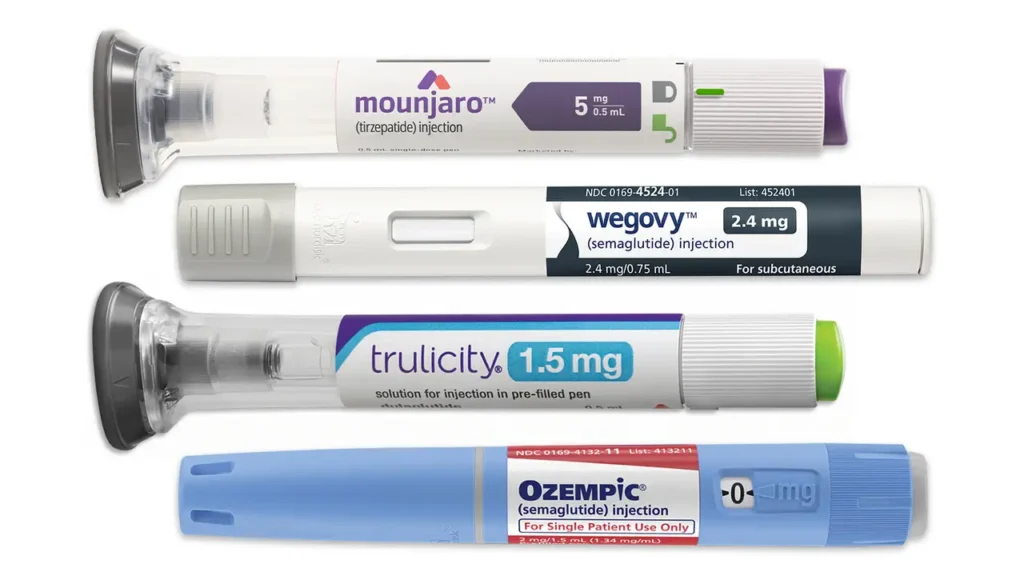Key Takeaways
- Pairing GLP-1 meds with a custom post-lipo nutrition plan controls hunger and promotes an optimal healing process.
- Prioritizing balanced meals with plenty of protein, anti-inflammatory foods, smart carbs, good fats, and micronutrients is critical to recovery and sustaining energy.
- Nibbling small meals often and eating mindfully may aid in handling a slowdown in digestion, changes in appetite, and fullness brought on by GLP-1 meds.
- Focus on hydration as it aids in recovery and staves off common side effects such as constipation, particularly with a heavier fiber consumption.
- By carefully managing your nutrition plan post-lipo for GLP-1 patients, you can mitigate side effects, support healing, and build a strong foundation for sustainable weight management.
- Establishing achievable, sustainable weight goals and consulting with healthcare providers throughout encourages enduring achievement and wellness.
A post lipo nutrition plan for GLP-1 patients is a method of eating that promotes recovery and maintains weight stability after liposuction with GLP-1 medications. Nutritious eats can get your body healing quicker, reduce the chances of inflammation, and even keep blood sugar at bay. A lot of individuals are on GLP-1 medications such as semaglutide or liraglutide for weight reduction or diabetes, and these medications can alter the body’s reaction to food post-surgery. Getting sufficient protein, hydrating well and bypassing excess sugar can go a long way. Simple, balanced meals are best. The second section covers what to eat, what to avoid, and how to structure a daily meal plan to fit these requirements.
The Dual Challenge
Nutrition post-liposuction, on GLP-1s, is a dual challenge. Weight loss and maintaining a balanced diet both count for recovery and long-term outcomes. For those with obesity or prediabetes, this equilibrium is even more difficult to achieve. GLP-1s can alter your hunger and metabolism, whereas liposuction requires deliberate eating to support healing and prevent rebound weight gain.
GLP-1 Medications
GLP-1 receptor agonists such as liraglutide or semaglutide alter how the body responds to food. They slow digestion and boost fullness, which causes most individuals to consume fewer calories, which is great for losing weight — with research finding around 10% weight loss after only 20 weeks for some patients. They can alter the palatability of foods, encouraging individuals to opt for less fatty, high-calorie foods. The negative is the typical side effects — nausea, vomiting and abdominal pain — which can make it difficult to eat balanced meals or retain sufficient protein and nutrients. By tuning the diet–eating small meals throughout the day, targeting easy digestible foods, and monitoring protein intake–you can help even out these impacts.
Liposuction Recovery
Following liposuction, your body requires the correct nutrition to recover. Protein is crucial—studies show 1.4–2.4 g/kg bodyweight to preserve muscle while shedding fat. Meals should be a good mix of enough carbs to energize and good fats for cell repair. Calorie counting matters as well since over eating can negate the surgery’s advantages. Snacks throughout the day can keep blood sugar stable, particularly when medication makes appetite erratic.
A Unique Intersection
For GLP-1 patients post-lipo, the meal plan has to serve both the medical therapy and the surgical recovery. Everyone’s requirements will vary, conditioned by their health, habits and how they respond to the medications. A plan that works will blend protein, fiber, and healthy fat, while monitoring for side effects that might interfere with nutrient absorption. This is a team effort — physicians, nutritionists and the patient collaborating for consistent, healthy weight loss and optimal healing.
The Nutrition Blueprint
Post-lipo nutrition for GLP-1 patients requires support for healing, weight management and muscle. Covering each of the five food groups plus a daily multivitamin helps bridge the nutritional gaps. Hydration is key–2.4–3 liters (80–100 ounces) of fluid per day will help your recovery. It’s easier to track progress weekly and to plan your meals.
1. Prioritize Protein
Eating sufficient protein post lipo is imperative. Protein keeps the muscle loss monsters at bay, especially considering that losing weight can mean losing muscle, which can make even everyday activities harder. Lean meats, fish, eggs, Greek yogurt, and plant-based proteins such as lentils and tofu are all really good options. These choices support satiety for longer, which aligns with the appetite-suppressing properties of GLP-1s. Incorporate protein into each meal, from morning omelets to lunch salads with beans or chicken. Beware of processed meats — they can have added fat and salt. Choose grilled or baked instead of fried.
2. Embrace Anti-Inflammatories
Anti-inflammatory, healing foods need to be on the plate. Bright-colored fruits and vegetables, oats, brown rice, and whole grain bread provide post-workout recovery with fiber, vitamins and minerals. Processed foods such as chips, pastries and sodas can exacerbate swelling and delay healing. Herbs and spices—such as turmeric, ginger and garlic—are natural anti-inflammatory foods and add flavor without added salt.
3. Smart Carbohydrates
Choose fuels that provide sustained energy. Brown rice, quinoa, and whole-grain pasta are all pretty good examples. Avoid candies, white bread, and soda, as they can spike blood sugar and impede recovery. Pair your carbs with protein and healthy fats to maintain energy. Use a small plate or portion them out — calories accumulate quickly!
4. Healthy Fats
Nuts, seeds, olive oil, and fatty fish fuel your body to work optimally and keep hormones balanced. Pass on trans fats in packaged snacks and fatty cuts of meat. Heart healthy omega-3s from salmon or chia seeds be fat sources and types oriented, not fat quantity oriented.
5. Micronutrient Focus
Vitamins and minerals have a huge impact on healing and maintaining energy. Calcium, vitamin D, zinc and iron are particularly important. A daily multivitamin can help fill holes. From time to time a doctor will check blood levels to ensure you’re not deficient in something.
GLP-1 Medication Impact
GLP-1 meds, used globally for T2D & weight loss, alter the body’s digestion of food — particularly post-liposuction. Every GLP-1 medication uniquely impacts gut health, so nutrition protocols must align with medication activity and patient reaction.
| Medication Type | Key Features | Pros | Cons | Digestive/Nutrient Impact |
|---|---|---|---|---|
| Liraglutide | Daily injection, appetite control | Weight loss, T2DM aid | Nausea, GI upset | Slower digestion, less hunger |
| Semaglutide | Weekly injection, strong GLP-1 mimic | Long-acting, weight drop | Constipation | Delayed gastric emptying |
| Dulaglutide | Weekly, steady GLP-1 levels | Easy dosing, less peaks | Bloating, diarrhea | Alters nutrient uptake |
| Exenatide | Twice daily, quick action | Fast onset, appetite | Shorter duration | Mild GI changes |
Tuning your diet is essential because these drugs slow digestion and can decrease absorption. For instance, high-protein diets increase post-meal GLP-1, but low-protein diets don’t. Prebiotics and synbiotics can increase GLP-1 levels in diabetics, indicating the importance of particular diet choices. The GLP-1 response is often blunted by western-style breakfasts and sugary foods, so meal type does matter. Historical surgical standards even recommended discontinuing GLP-1 prior to anesthesia.
Slower Digestion
- Eat smaller meals more often through the day
- Space meals to avoid large portions in one sitting
- Opt for easy-to-digest foods such as soft grains, cooked vegetables, lean proteins.
- Be wary of bloating or fullness after super fatty or super fiber foods and adjust
- Grind well to assist enzymes and facilitate absorption
Appetite Regulation
Mindful eating assists those on GLP-1 medications navigate diminished appetite signals. Slowing down and recording satiety does wonders in preventing gluttony. Food logs can detect when cravings rise or fall, assisting in adjusting future meals. Hunger fluctuations might require meal plans that are adaptable, aligning with the body’s shifting cues.
Blood Sugar Stability
After liposuction, stable blood sugar is important. Choose low glycemic foods—legumes, oats, nuts. It contains fiber, which slows sugar rise, so toss in beans, berries, and seeds often. Discover sugar-spiking foods by tracking glucose and observing meal impact. Regular check-ins keep the diet calibrated.
Hydration is Key
Hydration is among the most crucial components of liposuction recovery, particularly for individuals on GLP-1 drugs. Guess what? Our bodies are comprised of approximately 60 percent water. If you’re not drinking enough, healing can stall, skin can look less taut, and the danger of swelling, infection, and other issues increases. Post-liposuction, 2–2.5 liters (8–10 cups) of water a day keeps your blood flowing nicely and aids tissue repair. This quantity is sufficient to aid in flushing out swelling, occasionally within just a few hours, and maintains your skin looking supple and healthy!
Water is useful for more than healing bruises and swells. It makes your gut function better, which is important because GLP-1 drugs and high-fiber diets tend to slow down the gut or make you feel full sooner. If you don’t hydrate with your increased fiber intake, you can become constipated or have a sore stomach – not fun. Swelling in arms or legs, which can occur after liposuction—particularly in lymphedema patients—improves with proper hydration. Research finds that regular hydration can cause a 90 percent reduction in arm swelling for these patients.
Dehydration is a very real possibility following surgery and can manifest as fatigue, irritability, digestion problems or more severe complications such as infections. Indeed, almost 60% of dehydrated post-surgery patients contract some form of infection. Keep an eye out for symptoms like dry mouth, dark pee, headache or dizziness. These are all signs you need to hydrate.
Tips for staying hydrated during recovery:
- Aim for 2–2.5 liters (8–10 cups) of water daily
- Drink a glass of water with every meal and snack.
- Carry a refillable water bottle
- Opt for water or clear broths instead of sugary or carbonated beverages.
- Watch urine color—it should be pale yellow
- Bonus points if you add a slice of lemon or cucumber for flavor sans sugar.
- Set reminders if you forget to drink regularly
Navigating Side Effects
GLP-1’s may induce beneficial changes post-lipo, but the majority of patients experience side effects, particularly during the initial weeks. Nausea, fullness and changes in digestion are common, with as many as 44% experiencing nausea and approximately 32% reporting diarrhea. These symptoms frequently subside as time goes on, but adjusting your diet sooner rather than later is crucial. Collaborating with your healthcare providers helps identify problems and optimize your strategy for comfort and long-term success.
Combat Nausea
When nausea strikes, light, bland foods—such as plain rice, boiled potatoes or crackers—will come to the rescue. Strong smells or spicy foods tend to exacerbate the situation, so it’s best to eat plain meals.
Eating smaller, frequent meals—shoot for 4 – 6 small servings a day—gives your body a chance to adjust and can stave nausea off. Hydration counts as well. Being well-hydrated, about 2.3–3 liters a day, staves off headaches and dizziness and keeps the gut reset during recovery.

Manage Fullness
Side note: meal plans should emphasize portion control. Use smaller plates or measure servings to not overload the stomach. Mindful eating—chew slowly, put down your fork between bites—allows your body to catch up and tell you when it’s full.
Lighter meals, such as steamed vegetables, lean meats, and soft fruits, are easier to process post-surgery. Trust your comfort instincts and pass on any foods that cause bloating, heartburn or pressure. Don’t lie down two to three hours after eating to reduce the risk of heartburn and discomfort.
Prevent Constipation
Fiber-rich staples such as oats, lentils, and berries keep digestion smooth and curb constipation. If diet alone isn’t enough, a fiber supplement like sugar free metamucil or colace or miralax can be helpful.
Continue to sip water during the day to keep the fiber doing its work. Try to move more, even a short walk, to wake up the gut.
Listen to your body’s call to the bathroom and avoid holding urges in, as this can exacerbate constipation.
Communication with Healthcare Providers
Tell your provider about any side effects, no matter how minor.
Bring up changes in your appetite, digestion, or comfort.
Long-Term Success
Long term success after lipo for patients on GLP-1 requires a specific plan. To maintain health improvements from both the surgery and the drug, most folks discover that returning to fundamentals, such as a solid meal plan, consistent exercise, and reliable calorie counting, prepares them for the long haul. Below are steps that help set and keep realistic weight goals:
- Begin with a well-defined baseline. Record your weight, eating patterns and activity levels for the week.
- Establish minimal weight loss goals — 0.5 to 1 kg / week.
- Count calories every day–with apps or a food journal. This assists identify patterns and prevents minor slides from turning into major downsides.
- Aim for a minimum of 150 minutes a week of moderate aerobic exercise. Stretch this out to three to five days. Such as brisk walking, biking, or swimming.
- Select a diverse, nutrient rich, diet. Add lean proteins, whole grains, fruits and vegetables. Make an effort to keep meals uncomplicated and avoid heavily processed foods.
- Be sure every meal includes plenty of protein, which preserves lean muscle when you lose or gain weight. Eggs, fish, tofu, and beans are all great choices.
- Hydrate, 1.5-2 liters for most adults each day.
- Sneak in a little strength work during the week. Lifting light weights or performing bodyweight exercises such as squats aids in preserving muscle mass.
Ongoing nutritional counseling is crucial. Your dietitian can shift the plan as needs shift, provide strategies to manage GI side effects, or assist in staving off vitamin deficiencies. Keeping an eye on your weight is key, as well. Monitor your progress weekly, and modify if you observe weight gaining.
GLP-1s see 5–18% weight loss in trials, with improved heart and metabolic health. When you cease GLP-1s, a holistic, whole-patient diet and lifestyle helps retain these successes. It’s not just about what you eat—quality sleep, stress management, strong relationships, and reduced substance use all contribute to sustainable health.
Conclusion
Simple but real food was my focus to create a solid foundation post lipo on GLP-1. Consume lean meats, fresh fruits, and crisp greens daily. Hydrate well. Adhere to small, consistent meals. Listen for how your body’s feeling and switch things up if you need to! Trust your doctor and ask questions if you feel out of sorts. A lot of folks experience gradual success with sticking it simple. Having accountability from friends or a pro can keep you on track. Real food, real steps and real teamwork make the plan work. For more customized suggestions, contact a health coach or have your physician help you formulate your meal plan.
Frequently Asked Questions
What is the best nutrition plan after liposuction for GLP-1 patients?
A balanced diet with lean proteins, whole grains, fruits and vegetables. Prioritize micro meals for optimal recovery and glp 1 side effect control. As always, listen to your doctor.
How does GLP-1 medication affect post-liposuction nutrition?
GLP-1 meds can curb appetite and slow digestion. This implies that you might become full faster. Opt for nutrient dense foods to satisfy your body’s nutritional requirements with less volume.
Why is hydration important after liposuction and while on GLP-1 therapy?
Water keeps the body hydrated, which aids in the healing process and promotes digestion. Stay hydrated during the day — both lipo and GLP-1’s can increase your risk for dehydration.
Can I experience side effects when combining GLP-1 medications and recovering from liposuction?
Yes, potential side effects are nausea, constipation or fatigue. Small meals and hydration will ease the discomfort. Check with your doctor if symptoms continue.
What nutrients are most important after liposuction for GLP-1 patients?
Protein, vitamins and minerals for healing. Try to incorporate lean meats, dairy, legumes, fruits and vegetables. Supplements might be necessary if you’re unable to satisfy your requirements with food.
How can I maintain my results long-term?
Go with a healthy balanced diet and remain active. Regular follow-ups with your healthcare team encourage long-term results and help resolve any nutrition or medication issues.
Are there foods I should avoid post-liposuction while on GLP-1 medication?
Stay away from greasy, fried foods and sweets, which can increase nausea and impede healing. Emphasize real, minimally processed foods.









